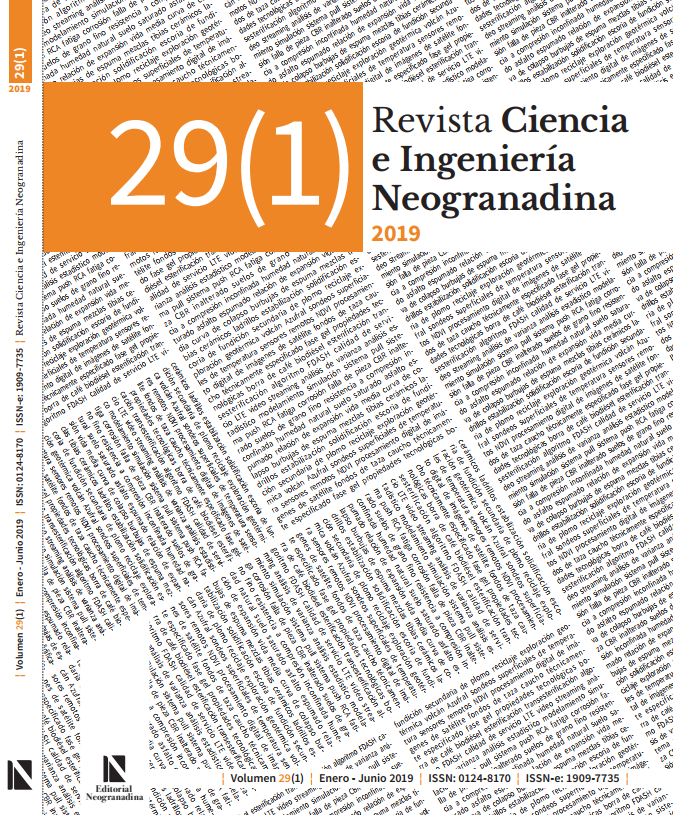Using Secondary Lead Smelter Slag in Ceramic Bricks
Abstract
Secondary lead slag is a waste product obtained from the smelting of used lead battery,
and it becomes a major air, soil, and water pollutant when not properly stabilized. Thus, this study
assesses the technical feasibility of aggregating this waste to produce ceramic bricks and to test
the immobilization of several heavy metals contained in the slag used for prepared products. The
results revealed the feasibility of substituting 15% of the clay with slag, thereby reporting an improvement in the compressive strength of bricks in which this waste was aggregated, unlike regular bricks.
Additionally, the study determined the immobilization of lead, arsenic, and selenium in these fnal
products
Downloads
Languages:
esSupport agencies:
Universidad Nacional de ColombiaReferences
H. Vest. (2002). Fundamentos del reciclaje de acumuladores de plomo-ácido [En línea]. Disponible en:
https://docplayer.es/14490135-Fundamentos-del-reciclaje-de-acumuladores-de-plomo-acido.html
Consejo Nacional de Producción Más Limpia. (2011). Guía de mejores técnicas disponibles para el manejo de
escorias de metalúrgica en el sector de fundición [En línea]. Disponible en: http://www.cpl.cl/archivos/documentos/28.pdf
M. Sánchez y M. Sudbury, “Physicochemical characterization of copper slag and alternatives of friendly environmental management”, Journal of Mining and Metallurgy B: Metallurgy, vol. 49, no. 2, pp. 161-168, 2013. https://doi.org/10.2298/JMMB120814011S
M. Reuter, Y. Xiao y U. Boin. “Recycling and environmental issues of metallurgical slags and salt fluxes, Proc”, en VII International Conference on ‘Molten slags fluxes and salts’, Cape Town, South Africa, 2004, pp. 349-356.
A. Lassin, P. Piantone, A. Burnola, F. Bodénana, L. Chateau, C. Lerouge, C. Crouzet, D. Guyonnet y L. Bailly, “Reactivity of waste generated during lead recycling: an integrated study”, Journal of Hazardous Materials, vol. 139, no. 3, pp. 430-437, en., 2017. https://doi.org/10.1016/j.jhazmat.2006.02.055
Décret n° 2002-540 du 18 avril 2002 relatif à la classifcation des déchets.
Colombia, Ministerio de Ambiente y Desarrollo Sostenible, Decreto 4741 de 2005, Por el cual se reglamenta parcialmente la prevención y manejo de los residuos o desechos peligrosos generados en el marco de la gestión integral. Bogotá: Diario Ofcial.
A. Macías, S. Goñi, A. Guerrero y E. Fernandez, “Inmovilización/solidifcación de residuos tóxicos y peligrosos en matrices de cemento”, Materiales de Construcción, vol. 49, no. 2, pp. 5-16, jun., 1999. https://doi.org/10.3989/mc.1999.v49.i254.446
J. R. Conner y S. L. Hieffner, “Te history of stabilisation/solidifcation technology”, Enviromental Science Technology, vol. 28, no. 4, pp. 325-396, jun. 2010. https://doi.org/10.1080/10643389891254241
F. P. Glasser, “Fundamental aspect of cement solidifcation and stabilization”, Journal of Hazardous Materials, vol. 52, no. 2-3, pp. 151-170, abr., 1997. https://doi.org/10.1016/S0304-3894(96)01805-5
H. Motz y J. Geiseler, “Products of steel slags an opportunity to save natural resources”, Waste Management, vol. 21, no. 3, pp. 285-293, jun., 2001, https://doi.org/10.1016/S0956-053X(00)00102-1
M. Knežević, M. Korać, Ž. Kamberović y M. Ristić,“Possibility of secundary lead slag stabiliation in concrete with presence of sected additives”, Association of Metallurgical Engineers of Serbia, vol. 16, no. 3, pp. 195-204, jun., 2010.
M. Penpolcharoen, “Utilization of secondary slagas construction material”, Cement and Concrete Research, vol. 35, no. 6, pp. 1050-1055, jun., 2005. https://doi.org/10.1016/j.cemconres.2004.11.001
N. Saikia, G. Cornelis, G. Mertens, J. Elsen, K. V. Balen, T. V. Gerven y G Vandecasteele, “Assessment of Pbslag, MSWI bottom ash and boiler and fly ash for using as a fne aggregate in cement mortar”, Journal of Hazardous Materials, vol. 154, no. 1-3, pp. 766-777, jun., 2008. https://doi.org/10.1016/j.jhazmat.2007.10.093
H. F. Hassan y K. Al-Jabri, “Laboratory evaluation of hot-mix asphalt concrete containing copper slag aggregate”, Journal of Materials in Civil Engineering, vol. 23, no. 6, pp. 879-885, jun., 2011. http://dx.doi.org/10.1061/(ASCE)MT.1943-5533.0000246
I. Ponsot y E. Bernardo, “Self glazed glass ceramic foams from metallurgical slag and recycled glass”, Journal of Cleaner Production, vol. 59, pp. 245-250, nov., 2013. https://doi.org/10.1016/j.jclepro.2013.06.029
T. Alex, A. Kalinkin, S. Nath, B. Gurevich, E. Kalinkina, V. Tyukavkina y S. Kumar, “Utilization of zinc slag through geopolymerization: influence of milling atmosphere”, International Journal of Mineral Processing, vol. 123, pp. 102-107, sept., 2013, https://doi.org/10.1016/j.minpro.2013.06.001
S. Onisei, Y. Pontikes, T. V. Gerven, G. N. Angelopoulos, T. Velea, V. Predica y P. Moldovan, “Synthesis of inorganic polymers using fly ash and primary lead slag”, Journal of Hazardous Materials, vol. 205-206, pp.
-110, febr., 2012. Doi: 10.1016/j.jhazmat.2011.12.039
Y. Pontikes, L. Machiels, S. Onisei, L. Pandelaers, D. Geysen, P. T. Jones y B. Blanpain, “Slag with a high Al
and Fe content as precursors for inorganic polymers”, Aplied Clay Science, vol. 73, pp. 93-102, mzo., 2013. doi:10.1016/j.clay.2012.09.020
O. Gencel, M. Sutcu, E. Erdogmus, V. Koc, V. Cay y M. Gok, “Properties of bricks with waste ferrochromium slag and zeolite”, Journal of Cleaner Production, vol. 59, pp. 111-119, nov., 2013. https://doi.org/10.1016/j.jclepro.2013.06.055
N. Quijorna, G. San Miguel y A. Andrés, “Incorporation of Waelz slag into commercial ceramic bricks: a practical example of industrial ecology”, Industrial & Engineering Chemistry Research, vol. 50, no. 9, pp.
-5814, mzo., 2011. DOI. 10.1021/ie102145h
L. Zhang, “Production of bricks from waste materials: a review”, Construction and Building Materials”, vol.
, pp. 643-655, oct., 2013. https://doi.org/10.1016/j.conbuildmat.2013.05.043.
J. L. Amorós Albaro, Manual para el control de la calidad de materias primas arcillosas, 2.ª ed. Castellón: Instituto de Tecnología Cerámica, 2004.
B. Coya, E. Marañon y H. Sastre, “Ecotoxicity assessment of slag generated in the process of recycling lead from waste batteries”, Resources, Conservation and Recycling, vol. 29, no. 4, pp. 291-300, jun., 2000. https://doi.org/10.1016/S0921-3449(00)00054-9
Colombia, Ministerio de Ambiente, Vivienda y Desarrollo Territorial (30 dic. 2005). Decreto 4741, Por el cual se reglamenta parcialmente la prevención y manejo de los residuos o desechos peligrosos generados en el marco de la gestión integral. Bogotá: Diario Ofcial.
M. Malki, P. Echegut, C. Bessada y I. Nuta, “Structure and properties of glasses obtained by recycling of secondary lead from acid battery plants”, Glass Technology, vol. 46, no. 4, pp. 305-310, ag., 2005.
S. Hreglich, R. Falcone, G. Nassetti y G. Gattelli, “Inertisation of slags from the treatment of end of life
automotive batteries and their reuse in the production of heavy clay products with soundproofng properties”, Glass Technology: European Journal of Glass Science and Technology Part A, vol. 49, no. 6, pp. 313-316, dic., 2008
L. A. Villareal Jiménez, “Uso de lodo de papel y arena sílica para la fabricación de ladrillos y tabla roca”, tesis de grado, Universidad de Las Américas, Puebla, México, 2004.
L. Moreno, A. de la Losa, M. Meléndez, M. L. Rodríguez y J. R. Quintana, “Influencia de las condiciones de pH y tamaño de grano en la capacidad de lixiviación de As en los materiales de la aureola metamórfca del skarn granítico de Carlés”, Boletín Geológico y Minero, vol. 117, no. 3, pp. 401-412, jul., 2006.
J. M. McArthur, P. Ravenscrof, S. Safulla y M. F. Tirlwall, “Arsenic in groundwater: testing pollution mechanisms for sedimentary aquifers in Bangladesh”, Water Resources Research, vol. 37, no. 1, pp. 109-117,
jun., 2001. https://doi.org/10.1029/2000WR900270
G. de Angelis, F. Medicib, M. R. Monterealia y L. Pietrelli, “Reuse of residues arising from lead batteries recycle: a feasibility study”, Waste Management, vol. 22, no. 8, pp. 925-930, dic., 2002. https://doi.org/10.1016/
S0956-053X(02)00082-X
J. M. Magalhães, J. E. Silva, F. P. Castro y J. A. Labrincha, “Effect of experimental variables on the inertization of galvanic sludges in clay-based ceramics”, Journal of Hazardous Materials, vol. 106, no. 2-3, pp. 139-147, en., 2004. https://doi.org/10.1016/j.jhazmat.2003.11.001
N. Quijorna, A. Coza, A. Andresa y C. Cheeseman, “Recycling of Waelz slag and waste foundry sand in red
clay bricks”, Resources, Conservation and Recycling, vol. 65, pp. 1-10, ag., 2012. https://doi.org/10.1016/j.resconrec.2012.05.004
Naciones Unidas, “Conferencia de las Partes en el Convenio de Basilea sobre el control de los movimientos transfronterizos de los desechos peligrosos y su eliminación Décima reunión Cartagena (Colombia), 17 a 21 de octubre de 2011” [En línea]. Disponible en: http://www.basel.int/Portals/4/Basel%20Convention/docs/pub/techguid/cement/06a3r1s.pdf
V. Nikolić, M. Komljenović, N. Marjanović, Z. Baščarević y R. Petrović, “Lead immobilization by geopolymers based on mechanically activated fly ash”, Ceramics international, vol. 40, no. 6, pp. 8479-8488, jul., 2014. https://doi.org/10.1016/j.ceramint.2014.01.059
| Article metrics | |
|---|---|
| Abstract views | |
| Galley vies | |
| PDF Views | |
| HTML views | |
| Other views | |












